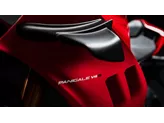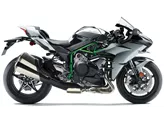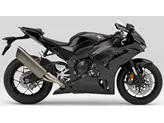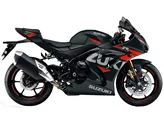Kawasaki Ninja ZX-10R 2016 vs. BMW S 1000 RR 2015

Kawasaki Ninja ZX-10R 2016

BMW S 1000 RR 2015
Overview - Kawasaki Ninja ZX-10R 2016 vs BMW S 1000 RR 2015
The Kawasaki Ninja ZX-10R 2016 and the BMW S 1000 RR 2015 are both high-performance supersport motorcycles that offer impressive specifications and features.
In terms of engine and drivetrain, both bikes have an inline four-cylinder engine with similar displacement. The Kawasaki Ninja ZX-10R has a slightly smaller bore and stroke compared to the BMW S 1000 RR, but it still manages to produce slightly more horsepower at 200.1 HP compared to the BMW's 199 HP. The torque figures are also similar, with the Kawasaki producing 114.3 Nm and the BMW producing 113 Nm. Both bikes have a compression ratio of 13 and come equipped with a 6-speed transmission.
In terms of suspension, both bikes feature a swingarm rear suspension. However, the Kawasaki Ninja ZX-10R comes with an upside-down telescopic fork front suspension, while the BMW S 1000 RR has a telescopic fork front suspension. This difference in suspension design may result in slightly different handling characteristics.

Kawasaki Ninja ZX-10R 2016
Both bikes have an aluminum frame, which provides a lightweight yet rigid structure. This helps improve handling and stability at high speeds.
When it comes to braking, both bikes are equipped with double disc brakes at the front. The Kawasaki Ninja ZX-10R features radial, petal technology brakes, while the BMW S 1000 RR has radial brakes. Both bikes offer excellent braking performance.
In terms of dimensions and weights, both bikes have the same front and rear tire widths and diameters. The Kawasaki Ninja ZX-10R has a slightly shorter wheelbase at 1415 mm compared to the BMW S 1000 RR's 1425 mm. The seat height is also slightly lower on the Kawasaki at 813 mm compared to the BMW's 815 mm. Both bikes have a fuel tank capacity of around 17 liters.
Now let's discuss the strengths and weaknesses of each bike. The Kawasaki Ninja ZX-10R 2016 has a great chassis geometry, which contributes to its excellent handling and stability. It also comes with high-quality chassis components, ensuring a smooth and comfortable ride. The brakes on the Kawasaki are also highly praised for their performance. Additionally, the Ninja ZX-10R is equipped with a wide range of electronics, including traction control, ABS, and multiple riding modes, enhancing the overall riding experience.

BMW S 1000 RR 2015
On the other hand, the BMW S 1000 RR 2015 has a superb shift assistant, which allows for quick and seamless gear changes. The engine on the BMW is incredibly powerful and rev-happy, providing exhilarating acceleration. The S 1000 RR also offers a great range of accessories, allowing riders to customize their bike to their preferences. Furthermore, the BMW comes with a race-ready data logging tool and calibration tool, which can be useful for professional riders.
In terms of weaknesses, the Kawasaki Ninja ZX-10R 2016 has a cockpit that may not be optimal for readability, which could be a minor inconvenience for some riders. On the other hand, the BMW S 1000 RR 2015 has a chassis that may reach its limit quickly in the hands of professional riders, potentially limiting its performance in certain situations.
Overall, both the Kawasaki Ninja ZX-10R 2016 and the BMW S 1000 RR 2015 are impressive motorcycles with their own strengths and weaknesses. Riders looking for a bike with excellent handling and a wide range of electronics may prefer the Kawasaki, while those seeking a bike with a powerful engine and a range of accessories may lean towards the BMW. Ultimately, the choice between these two bikes will depend on the individual rider's preferences and priorities.
Technical Specifications Kawasaki Ninja ZX-10R 2016 compared to BMW S 1000 RR 2015
Pros and Cons in comparison
Pros and Cons in comparison
Kawasaki Ninja ZX-10R 2016

The ZX-10R Ninja has a certain majesty, at the first rollout it seems very stable, you have to force it into the radius a little. After a few laps, however, this effect is transformed into an incredible precision that allows a pinpoint line. The engine has now really become noticeably stronger and makes the Kawa an enormously good overall package that can please not only die-hard Kawasaki fans. The traction control on the Kawa is particularly positive and regulates very sensitively. You can even adjust the engine brake - so it certainly doesn't lack for electronic features. The ZX-10R is the only superbike that is already Euro4-compliant in 2016!
BMW S 1000 RR 2015

The BMW can still score points with hard facts in 2015. If you like top performance, you have to buy the BMW. It turns out incredibly powerful at the top and drives away the rest of the field from 200. Big and heavy riders will be able to benefit from this even more. BMW didn't make it easy for themselves with this bike and put together a very universal motorbike. If you were to do a comparison test with 50 different riders (from rookie to pro), the BMW would have the best average of all 1000cc bikes. The electronic chassis, but also the riding aids, make the pros fast and the beginners safe on the road. A top recommendation for a very broad target group. Very fast hobby riders will not be 100% satisfied with the standard suspension. If you don't want to modify the chassis, you should rather go for an R1M, a Panigale S or an RSV RF. If you want to convert anyway, the S 1000 RR is the strongest and most universal base. Surprisingly, the powerful machine also rides very well on country roads. All in all, it looks like a compromise, but it never feels like one in practice.
Price Comparison Avarage Market Price Kawasaki Ninja ZX-10R vs BMW S 1000 RR
There are a few key differences between a Kawasaki Ninja ZX-10R 2016 and a BMW S 1000 RR 2015. In terms of price, the actual average price of a Kawasaki Ninja ZX-10R 2016 is about 38% higher. A Kawasaki Ninja ZX-10R 2016 experiences a loss of 1,670 GBP in one year and 1,630 GBP in two years of ownership. This is offset by a loss of 1,580 GBP and 850 GBP for a BMW S 1000 RR 2015. Compared to BMW S 1000 RR 2015 there are less Kawasaki Ninja ZX-10R 2016 bikes available on the 1000PS.de Marketplace, specifically 4 compared to 8. It takes less time to sell a BMW S 1000 RR with 77 days compared to 100 days for the Kawasaki Ninja ZX-10R. Since model year 2005 1000PS.de editors have written 51 reviews for the Kawasaki Ninja ZX-10R and 135 reviews for the BMW S 1000 RR since model year 2010. The first review for the Kawasaki Ninja ZX-10R was published on 11/01/2004 and now has more than 2,900 views. This compares to more than 4,000 views for the first review on BMW S 1000 RR published on 16/04/2008.

















